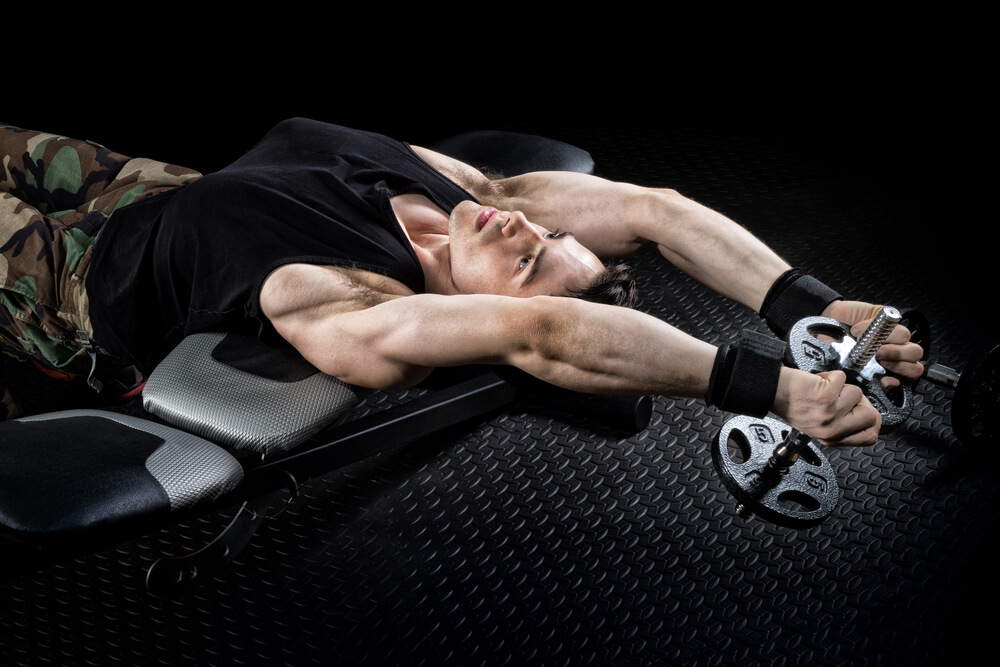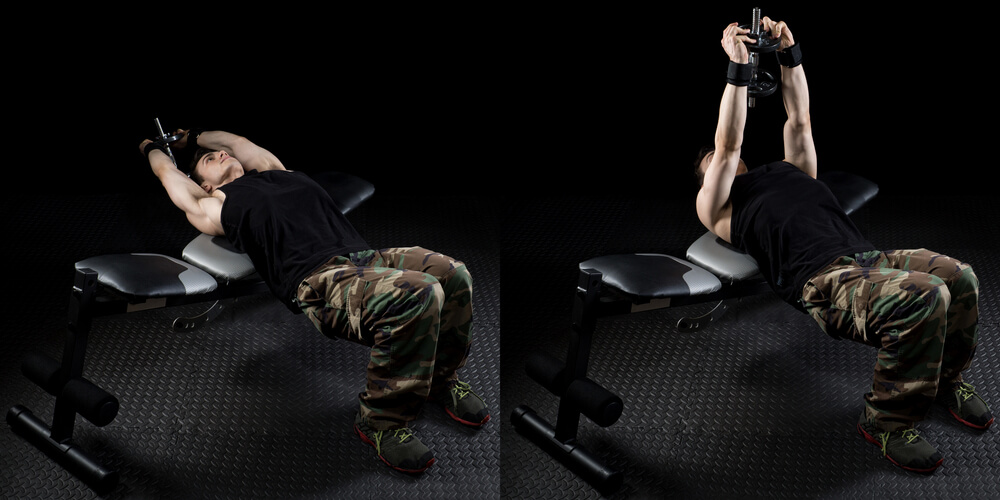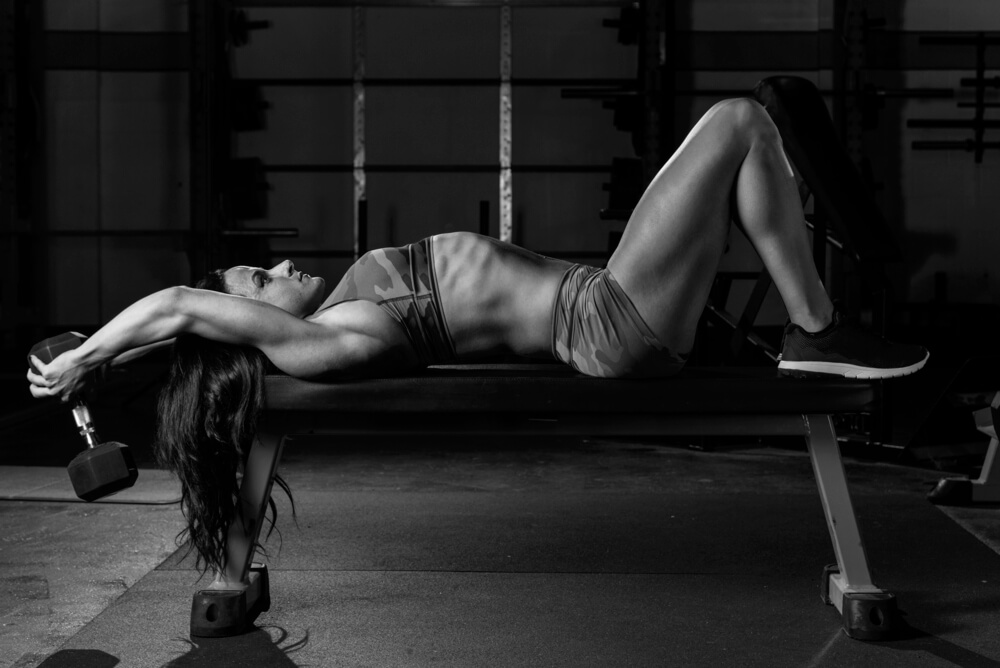 When you head out to lift weights at the gym, what is the first lift you go for on upper-body day? Chances are, it is the bench press. Today we will look into Dumbbell Pullover…
When you head out to lift weights at the gym, what is the first lift you go for on upper-body day? Chances are, it is the bench press. Today we will look into Dumbbell Pullover…
But why is that?
Not only does it work a large portion of your upper body muscles but it helps build upper chest. As a strong chest draws in so much attention, working it out is important. But you can’t build a great chest with just one exercise, and chances are you’re missing out on a great one. One of these exercises might be the dumbbell pullover.
Made famous by some of the most popular bodybuilders of all time, is it actually worth adding to your chest workout?
We’ve got all the answers for you right here.
What is the Dumbbell Pullover?
The dumbbell pullover is seemingly a lost weight lift.
With so many people focusing on the traditional chest presses, machine lifts, and bicep curls, it’s possible you haven’t actually seen someone at the gym performing the dumbbell pullover.
However, it is easy to do and, as long as you have a bench or side of a chair or even an ottoman at home, you can do this move just about anywhere.
The chest is the only major muscle group hit with this workout, so you’ll likely want to slide it into the end of your upper body routine (should you decide to add it). However, it stretches your chest muscles with a greater array of movement over most other chest exercises, which is what makes it so desirable.
With the chest press, you’ll begin with the top of your back laying on a bench. Don’t lay with the length of the bench though. Instead, you’ll lay perpendicular to the bench, so while your upper back is on the bench, your head is off and the lower half of your back is on the other end. Put your feet in standing position to anchor the lower portion of your body.
Now, hold a single dumbbell above your chest. Use both hands to grip the weight under the weight furthest from your body. Your arms should have a slight bend while you hold here.
This is done because you don’t want to lock your arms into position, and by maintaining a slight bend, you’ll put additional strain on your chest and even a bit on your biceps and triceps.
From here, slowly lower the dumbbell behind your head and let it decline as far as your shoulders allow. Once in the lowest position hold it here for a second. This allows your chest to experience the full strain of the lift.
Now, push the dumbbell back up to the starting position and again hold for another second.
This is a single rep.
A Warning Before Lifting
Before you jump right in and decide to test out the lift, make sure to inspect the dumbbell first.
If you use a dumbbell with removable plates you need to make sure everything is locked tight. The last thing you want is a face full of weighted plate, as you will have the weight elevated and going over your face throughout the workout.
Additionally, it is a good idea to place the weight on the bench next to you as you prep yourself for the lift.
This makes it easy to pick up before moving on with the lift.
Some Dumbbell Pullover Background
In the history of weightlifting, (which dates backs centuries), the pullover movement, in general, is relatively new. In fact, the pullover itself first saw major publicity around 1911, when the founder of Mil Barbell Company Alan Calvert started to teach lifters the barbell pullover.
He claimed it to be an excellent chest workout as it worked deeper tissue muscles over the traditional chest press. The move itself is slightly different from the current dumbbell pullover as a lifter would lay on a decline bench and hold a weighted barbell instead of a dumbbell.
However, the idea remained the same: to deeply target the chest muscles.
In general though, performing the lift on an incline bench proved to be awkward and, with the rise of machine lifts, the pullover seemed to disappear from gyms.
At least, until the world famous Arnold Schwarzenegger made his appearance.
Arnold is a major supporter of dumbbell workouts. He avoids machines almost altogether as machine lifts prevent your stabilizer muscles from engaging, which ultimately limits the quality of the lift. He also focused on dumbbells over barbells as it forces each side of the body to atone for its own weight and not rely on assistance from the other side.
Arnold has gone on record multiple times claiming the dumbbell pullover is a major reason as to what helped him achieve his ripped chest.
He stated the move helped work deeper than what a bench or chest press could do thanks to the stretch that takes place as the weight is lowered behind the head.
The move can be compared to the incline curl. With the incline curl, your bicep stretches further than normal, which places greater strain on the top of the bicep, allowing you to work it deeper and makes it one of the best bicep workouts around.
As the dumbbell pullover directly does the same with the chest, you’ll likely grow your chest faster with the move.
Are There Dangers?
Just about anything you do at the gym may include some level of danger.
If you’ve spent any kind of time on YouTube, chances are you’ve seen people doing all sorts of ill-advised activities with gym weights and pulleys (usually because they have no idea how to use the equipment), or they simply slip and fall off a treadmill. Even if you know what you’re doing with a particular lift, there is a chance of injury.
However, with that said, there are additional dangers with the dumbbell pullover you need to know about.
The major (potential) issue is your elbows. Traditionally, the dumbbell pullover is done with a similar amount of weight as what you would bench. When performing a bench press though you have several different joints engages, including your shoulder, elbow and wrist.
Plus, the weight is distributed so one joint doesn’t receive the brunt of the weight. With a dumbbell pullover, nearly all of the weight is placed on your elbows. So, if you’re attempting to lift a 200-pound dumbbell, all of this weight is going on your elbows. It is a substantial amount of weight, so if you suffer from any kind of elbow injury, you may want to avoid the lift.
This is also a lift you need to pay extra attention to how your body responds during the lift. If there is any kind of pain not associated with the stretching and contracting of the muscle you need to stop immediately.
Realistically, you may not even know if you have capable elbows that can handle this kind of weight until you begin, so are there any tests to perform in order to find out?
Yes, actually there are.
These are excellent measuring sticks to determine if you should consider performing the dumbbell pullover or if you should avoid it. For starters, can you perform a traditional overhead press (also known as a military press or shoulder press). While this move works different muscles, it puts a similar amount of strain on the elbows (especially with free weights). If you have a full range of pain-free motion while performing an overhead press, you likely will be fine with the dumbbell pullover.
Another test is to perform a chin-up or a pull-up with a full range of pain-free motion.
As long as you can do this, another exercise where a good amount of weight is placed on the elbows, you should be more than ready to try out the dumbbell pullover.
What Muscles Are Targeted With The Dumbbell Pullover?
If you discuss the dumbbell pullover with someone at the gym, you might hear a handful of lifters say it works the back more than the chest.
But Arnold says it is a chest workout, so who should you believe?
We tend to side with Arnold, yet it is important to look deeper into the workout to identify exactly the muscles hit. In a 2011 study published in the Journal of Applied Biomechanics, the strain placed on different muscles was measured in individuals performing the dumbbell pullover.
The pectoralis major received a bulk of the attention. While the latissimus dorsi did receive some work (when the weights are elevated above the chest it stretches the latissimus dorsi, which is what puts a strain on it).
The pectoralis major is not only your pectoral muscle but the very top of your arm as well. The latissimus dorsi muscle is a rectangularly shaped muscle that runs from the spine to the top of your butt over to your armpit.
By heavily hitting the chest and subsequently touching on the back, this makes the dumbbell pullover an excellent back and chest workout move.
Dumbbell Pullover Variations
Most traditional dumbbell pullover lifters lay perpendicular across the bench.
However, there are some who will tell you it is fine to lay naturally on the bench.
What is right for you?
Realistically, your chest will receive the same amount of attention. However, there are benefits to laying perpendicular across the bench. By using the bench in a traditional manor, you limit the amount of work your back receives. Additionally, your body’s core must remain tight while performing the move in the perpendicular position, which helps strengthen your abdominal and lower back.
So if you’re looking just to hit your back, either option is fine. If you’re going to do it though, you might as well take advantage of all the gains you can receive.
Workout Example With Dumbbell Pullovers
Your exact workout is going to depend on what kind of gain you’re going for.
If you want to increase strength, shoot for four reps per set before failure.
However, if you want to go for an increase in size, you want to shoot for anywhere between eight and 12 reps. Ideally, nine and 10 is the sweet spot, but you’ll fine-tune it as you go.
Start with your first set after you’ve decided on what you’re going for. If you’re going for an increase in strength and you’re able to perform more than four reps, you know you need to increase the weight for the second set. If you’re going for an increase in size and can perform more than 12 reps, you know you need to increase your weight.
Perform three sets of the dumbbell pullover, but leave some time in between sets.
You likely are lifting a considerable amount of weight and you do need to give your elbows some time to recover. Even if your muscles are able to take the weight, protect the ligaments within your elbows, because any damage to these areas of your arms and every other upper body workout you perform will be affected.
Remain mindful of what the body is doing when first starting off with this (or any) lift.
Conclusion
There is a general rule of thumb when it comes to weightlifting. If Arnold likes it you should probably listen.
Arnold swears by this move, and while it doesn’t have his name attached to it like the Arnold Press (check out our article regarding the Arnold Press for more details on it), he has gone on record to say it is one of his favorite chest exercises. The great thing about the dumbbell pullover is you can do it just about anywhere – including your home.
So, if you’re looking for ways to strengthen your chest and boost performance without just relying on the bench press, now is the perfect time to add the dumbbell pullover to your chest workout.
-Terry Asher
Terry Asher
Latest posts by Terry Asher (see all)
- Better Family – Product Review Liquid Daily 2 oz - Dec 16, 2024
- Post-Workout Recovery: The Key to Optimal Performance - Nov 25, 2024
- Pre-Workout Supplements – Everything You Need To Know - Nov 18, 2024












Pullovers are truly the forgotten exercise. Along with all the benefits mentioned in your newsletter the pullover is a great exercise to improve and maintain good posture.
Thanks for sharing pullover exercise article it gives us lot of information i like it.